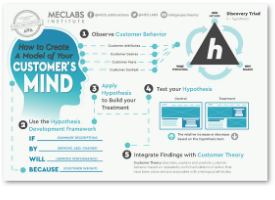New Social Media Metric: Impressions?
Eric Anderson, VP of Emerging Media at White Horse, made some interesting points about what social media metrics marketers should and should not be measuring based on what he sees going on in the marketplace.
Here are some pointers I gleaned from his webinar, “The Only 3 Social Media Metrics That Matter:”
1. Don’t over quantify
Tools that measure social media are taking a cue from the web analytics industry. The problem is a company’s true social media presence is far too nuanced to be captured by measurement software.
2. Don’t focus on direct response
Marketers shouldn’t be looking at direct response actions that can be driven from social media. It destroys the real potential of social media. The purpose should be engaging with people in places they like to be, not turning them off by trying to make them go somewhere else.
3. Don’t freak out about ROI
He doesn’t mean don’t measure ROI. Marketers need to acknowledge that the ROI is much more complicated than anything that can be measured, Anderson says.
It’s important to recognize that social media – when considered a component of marketing – is so relatively inexpensive that it does not require the ROI metric.
So, what does he think is the right kind of metric for social media? Impressions!
Pretend that each social media interaction is an impression.
If measured that way, it could tell you: Will this program extend my message to more people than if I didn’t engage? If I add a social media component to my campaign will it add more impressions than if I did not?
Categories: Marketing, Social Networking Evangelism Community impressions, metric, social media










Good points to be aware of. But what about the engagement aspect? I’d think that a “pseudo-ROI” metric might be called for in social media. Is what I’m blogging about/ tweeting about engaging? Are others re-tweeting? Are they responding to me?
If not, for all my “followers / friends / fans”, how many just reading and moving on? How many chose to follow me for the hope that I have an auto-follow app to follow them back?
Just because I’m using social media as a component of my overall marketing path doesn’t mean that I’m really “in” the dialogue. I could just be talking to thin air.
Just my take on it anyhow…
very nice post.
I think we are only at the beginning of Twitter and a lot of the measurements are still not fully developed. Will be great to follow the evolution.
1. Don’t over quantify. 2. Don’t focus on direct response. 3. Don’t freak out about ROI.
Did every bad employee I’ve ever had help you write them?!
😉
You mentioned the “low cost” of social media. Cost is deceptive when looking at social media as a component of a marketing plan. While the actual placement of the impressions has no direct cost, the labor costs of a well designed social marketing media campaign can be quite high. It takes a concerted effort to launch and maintain a consistent, and ongoing community presence in any social media.
I think that the questions, “Will this program extend my message to more people than if I didn’t engage? If I add a social media component to my campaign will it add more impressions than if I did not?” are valid, as social media is a great way to amplify your marketing messages and increase their reach. However, those who control marketing budgets do expect some measure of ROI. You can easily document increases in Twitter followers, LinkedIn connections, Facebook friends, and blog subscribers. And, as Alan suggest above, you can include Twitter retweet counts, @ responses, and direct messages.
Hi Everyone! Thanks for the great discussion about social media metrics. I agree that there must be some measurement of ROI. And, yes, an effective social media campaign can require high labor costs to create and maintain. What this post is trying to say is that if you think of social media as a component of each marketing campaign instead of in a silo, out there on its own, it’s easier to show the value. You can say: “Look, I added this social media component to this campaign and it contributed to this result.” Eric Anderson says maybe we should measure social media interactions the way we measure media impressions. Let that show the value contributed to the campaign.
If one of my marketers expressed these sloppy theories I would fire them. Attaching some unspecified and undefined social networking value add to campaigns is pointless. That said, we — and just about every other company — need to be in the SN game, if for no other reason just to watch, monitor and stay informed. But frankly none of the so-called ‘experts’ in this field are offering much in the way of solid data or research. Buying a ‘cool factor’ is low on my company’s marketing budget priority.